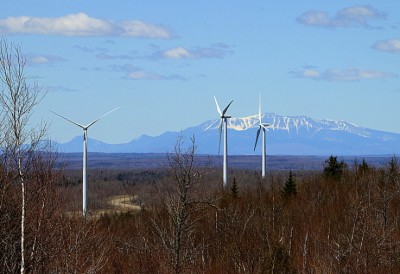Maine
Wind farm helps Lincoln lower tax rate, town officials say
By Nick Sambides Jr., BDN Staff, Sept. 20, 2011, bangordailynews.com
By Nick Sambides Jr., BDN Staff, Sept. 20, 2011, bangordailynews.com

Cherished view destroyed for $26/year, or 7 cents/day - photo by courtesy of Citizens' Task Force on Wind Power - Maine
LINCOLN, Maine – Owners of $100,000 properties will pay $26 less in town taxes annually than they would have paid last year under a new 19.86 mill rate town officials have set, they said Tuesday.
Town Manager Lisa Goodwin attributed the lower rate to the $42.2 million in value added to local taxes by the Rollins Mountain industrial wind-to-energy site as part of site owner First Wind’s tax increment financing agreement with the town.
Revenue from the project allowed town leaders to purchase or partially pay for several pieces of needed equipment without raising taxes, Goodwin said.
Without the TIF revenues, the equipment purchases and other expenses would have increased the town’s mill rate from last year’s 20.12 mills, under which $100,000 in property was assessed $2,012 in taxes, to 22.12 mills, or $2,212 for every $100,000 of property.
“That is one of the economic benefits of this project,” Goodwin said Tuesday of the Lincoln portion of the 40 1½-megawatt turbines on Rollins ridgelines in Burlington, Lee, Lincoln and Winn. “We don’t directly get their electricity, but we do get a benefit from the project.”
Under the 19.86 mill rate, $1,986 in taxes is owed annually on every $100,000 of property and $993 on every $50,000.
Town workers began mailing first-half tax bills late last week, Assessor Ruth Birtz said.
The paving of Frost Street, purchase of two Public Works Department vehicles, and partial payment of several other vehicles, among other things, were paid for by the TIF agreement with First Wind, Goodwin said.
The full value of the Rollins project wasn’t realized this year because the added value was assessed in April, before the project became operational. First Wind, parent company and owner of the site, held a ribbon-cutting on the site off Route 6 on July 20.
An estimated $18 million will be added to the project’s value in the next fiscal year, Birtz said.
Rollins Mountain was the state’s first site contracted to deliver its 60-megawatt capacity to customers of Bangor Hydro-Electric Co. and Central Maine Power Co., though proponents cautioned that ratepayers won’t see any immediate change in their electrical bills.
Also, such projects typically generate no more than 20 percent to 30 percent of their capacity, and First Wind, like most such developers, declines to disclose how much electricity its projects generate, citing industrial confidentiality. The others are the 42-megawatt Mars Hill project and the Stetson I and II sites, which generate a total of 83 megawatts.
First Wind spokesman John Lamontagne said ratepayers shouldn’t expect to see any great decreases in their electric bills because of Rollins, which provides a small portion of the total electricity Bangor Hydro and CMP draw upon. State public utilities studies have estimated that the project will save ratepayers $20 million to $40 million over its 20 years of life, depending on how much the cost of fossil fuels rises.
Opponents of the First Wind project say it has blighted the pastoral beauty of the Rollins mountains, threatens wildlife and land values, compromises human health and is likely to generate a fraction of its capacity.
They also characterize it as a bad investment for state and local governments and have worked to eliminate laws that fast-track such developments, which the opponents say are unconstitutional. None of this appears to affect local and international banking institutions that loaned the project $98 million in financing.
A Northeast leader for wind power generation as well as a destination for wind-power development companies, Maine has nearly 200 industrial turbines spinning or under construction around the state. Several projects are in development.
Proponents say the wind-power industry already has brought nearly $1 billion worth of investment into the state, $376 million of which has gone into the pockets of Maine workers or their local employers.
First Wind officials are satisfied with the Rollins Mountain project’s performance, Lamontagne said.
The wind farm has been fully operational 98 percent of the time and generated more electricity than company officials expected in August, its first full month of production, Lamontagne said.
He declined to say how much electricity that represented.
URL to article: https://www.wind-watch.org/news/2011/09/21/wind-farm-helps-lincoln-lower-tax-rate-town-officials-say/